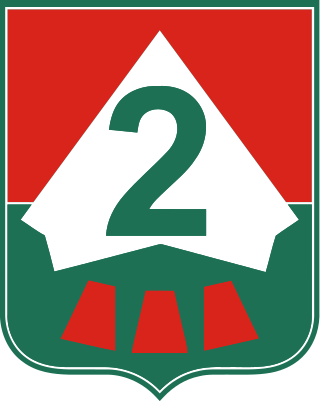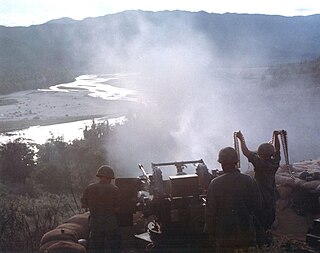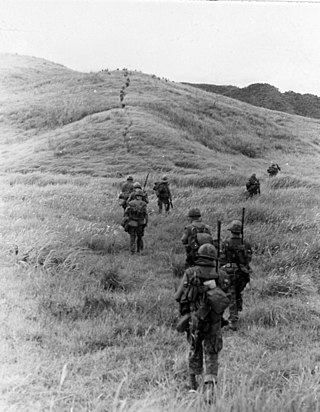
Operation Union II was a search and destroy mission in the Quế Sơn Valley carried out by the 5th Marine Regiment. Launched on 26 May 1967 the operation ended on 5 June. U.S. reported the People's Army of Vietnam (PAVN) lost 701 killed and 23 captured, while U.S. casualties were 110 killed and 241 wounded.

Operation Masher, also known as Operation White Wing, was the largest search and destroy mission that had been carried out in the Vietnam War up until that time. It was a combined mission of the United States Army, Army of the Republic of Vietnam (ARVN), and Republic of Korea Army (ROK) in Bình Định Province on the central coast of South Vietnam. The People's Army of Vietnam (PAVN) 3rd Division, made up of two regiments of North Vietnamese regulars and one regiment of main force Viet Cong (VC) guerrillas, controlled much of the land and many of the people of Bình Định Province, which had a total population of about 800,000. A CIA report in 1965 said that Binh Dinh was "just about lost" to the communists.

Operation Lam Son 719 or 9th Route – Southern Laos Campaign was a limited-objective offensive campaign conducted in the southeastern portion of the Kingdom of Laos. The campaign was carried out by the armed forces of South Vietnam between 8 February and 25 March 1971, during the Vietnam War. The United States provided logistical, aerial and artillery support for the operation, but its ground forces were prohibited by law from entering Laotian territory. The objective of the campaign was the disruption of a possible future offensive by the People's Army of Vietnam (PAVN), whose logistical system within Laos was known as the Ho Chi Minh Trail.

The Battle of Huế, was a major battle in the Tết Offensive launched by North Vietnam and the Việt Cộng during the Vietnam War. Initially losing control of most of Huế and its surroundings, the combined forces of South Vietnam and the United States gradually recaptured the city after a little over one month of intense fighting. The battle was one of the longest and bloodiest of the war, causing it to negatively affect the American public perception of the war. The battle is widely considered to be one of the toughest and most intense urban battles ever fought.

The Vietnamese Rangers (Vietnamese: Biệt Động Quân), commonly known as the ARVN Rangers or Vietnamese Ranger Corp (VNRC), were the light infantry of the Army of the Republic of Vietnam. Trained and assisted by American Special Forces and Ranger advisers, the Vietnamese Rangers infiltrated beyond enemy lines in search and destroy missions. Initially trained as a counter-insurgency light infantry force by removing the fourth company each of the existing infantry battalions, they later expanded into a swing force capable of conventional as well as counter-insurgency operations, and were relied on to retake captured regions. Later during Vietnamization the Civilian Irregular Defense Group program was transferred from MACV and integrated as Border Battalions responsible for manning remote outposts in the Central Highlands.

Phase Two of the Tet Offensive of 1968 was launched by the People's Army of Vietnam (PAVN) and Viet Cong (VC) against targets throughout South Vietnam, including Saigon from 29 April to 30 May 1968. The May Offensive was considered much bloodier than the initial phase of the Tet Offensive. U.S. casualties across South Vietnam were 2,169 killed for the entire month of May, making it the deadliest month of the entire Vietnam War for U.S. forces, while South Vietnamese losses were 2,054 killed. PAVN/VC losses exceeded 24,000 killed and over 2,000 captured. The May Offensive was a costly defeat for the PAVN/VC.

The 1st Division of the Army of the Republic of Vietnam (ARVN)—the army of the nation state of South Vietnam that existed from 1955 to 1975—was part of the I Corps that oversaw the northernmost region of South Vietnam, the centre of Vietnam.

The 2nd Division was a division of the Army of the Republic of Vietnam (ARVN)—the army of the nation state of South Vietnam that existed from 1955 to 1975. It was part of I Corps that oversaw the northernmost region of South Vietnam.

Operation Taylor Common was a search and destroy operation conducted by Task Force Yankee, a task force of the 1st Marine Division supported by the Army of the Republic of Vietnam (ARVN), southwest of Hội An from 6 December 1968 to 8 March 1969.

Operation Allen Brook was a US Marine Corps operation that took place south of Da Nang, lasting from 4 May to 24 August 1968.

Operation Double Eagle was a US Marine Corps and Army of the Republic of Vietnam (ARVN) operation that took place in southern Quảng Ngãi Province, lasting from 28 January to 17 February 1966, during the Vietnam War. The operation was mounted in conjunction with Operation Masher in northern Bình Định Province. The operation was inconclusive as the People's Army of Vietnam (PAVN) and the Vietcong (VC) had largely slipped away.

Operation Jeb Stuart was a U.S. Army operation during the Vietnam War that took place in Quảng Trị and Thừa Thiên Provinces from 21 January to 31 March 1968. The original operation plan to attack People's Army of Vietnam (PAVN) base areas was disrupted by the Tet Offensive and instead it saw the U.S. Army units fighting in the Battle of Quang Tri and the Battle of Huế.

Operation Pershing was an operation conducted by the 1st Cavalry Division, the 3rd Brigade, 25th Infantry Division, the Army of the Republic of Vietnam (ARVN) 22nd Division and the South Korean Capital Division in Bình Định Province, lasting from 12 February 1967 to 19 January 1968.
The Battle of Lỗ Giáng took place during the Vietnam War from 8-9 February 1968, when the People's Army of Vietnam (PAVN)'s 2nd Division attacked the Đà Nẵng Air Base as part of the Tet Offensive. The attack was repelled by U.S. Marine Corps and U.S. Army units.
Phase III of the Tet offensive of 1968 was launched by the People's Army of Vietnam (PAVN) and Viet Cong (VC) from 17 August to 27 September 1968. The offensive was divided into two waves of attacks from 17 to 31 August 1968 and from 11 to 27 September of that same year.

Operation Pipestone Canyon was a US Marine Corps, Army of the Republic of Vietnam (ARVN) and Republic of Korea Marine Corps (ROKMC) operation that took place on Go Noi Island, Quảng Nam Province, lasting from 26 May to 7 November 1969.

Operation Pickens Forest was a U.S. Marine Corps operation in Quảng Nam Province, South Vietnam that took place from 16 July to 24 August 1970.

Operation Imperial Lake was a U.S. Marine Corps, Republic of Korea Marine Corps and U.S. Army operation in the Quế Sơn District, Quảng Nam Province, South Vietnam that took place from 1 September 1970, to 7 May 1971. It was the last operation of the 1st Marine Division during the Vietnam War.

Operation Badger Tooth was a search and destroy mission in the Street Without Joy area of Quảng Trị Province carried out by the 3rd Battalion, 1st Marines. Launched on 26 December 1967 the operation ended on 2 January 1968. The Marines reported the People's Army of Vietnam (PAVN) lost 131+ killed, while US casualties were 48 killed.

The attacks on Da Nang, were a series of attacks in the Tet Offensive launched by the North Vietnamese People’s Army of Vietnam (PAVN) and the Viet Cong (VC) during the Vietnam War. The attacks were repulsed by combined United States Marine Corps (USMC), United States Army, Army of the Republic of Vietnam (ARVN) and Republic of Korea Marine Corps (ROKMC) forces with the PAVN/VC suffering heavy losses.


















